

|
Home Updates Hydros Cars Engines Contacts Links Racing ←Previous Contact On The Wire |
Hidden in plain sight?
Some will recall the strange series of circumstances that led to the identification of Jim Dean's European Championship car in 2022. However, the tale has taken a more complicated and interesting turn through being able to connect numerous pieces of information that had been available for quite some time, yet with their significance remaining unrealised. It was another of those 'hadnabinfas' that has allowed us, more or less, to produce another fascinating insight that covers 65 years of tethered car racing.
|
The elements were all there, starting with the 5cc bevel drive car (right) that Lyndon Bedford has been running for the last three years at Buckminster, previously run by his dad, Ken Bedford, principle of the ETA company and producer of the famous range of engines. Next was a photo album from Lyndon that we published in an earlier car archive, but importantly with a series of images emailed to us more recently. Add to that a 5cc car in the US, believed by OTW to be one of Jim Dean's from 1956, a plan passed to Oliver Monk from David Giles, a box of goodies that had not been fully delved into for sixty years, Dean's own Model Maker articles, and suddenly there was a moment of clarity. It all came to a head at the September 2023 BTCG meeting where Oliver brought his plan, Hugh an original ZN 5cc pan and Lyndon, his Dad's 5cc car. |
|
Comparing the three revealed that Lyndon's car was not based on a ZN pan as had been previously assumed but something significantly more rare, an Ian Moore Number 11. This was the 5cc version of his Shadow, available in the early 50s as two distinct castings. The first, a true Shadow where the lugs had to be cut off the motor and a second version with fairings to allow the engine to be bolted in conventionally. The Bedford ETA car was a Moore #11, not a ZN. Suspicions had been roused previously by Lyndon's car that not all was quite as it seemed as the pan handle had a decidedly odd dog leg in it to clear the rear tyre, as did the one in the US, but not apparent on the ZN casting.
Back home and a chance to look at Dean's 1956 article, and yes, his was the same, also a Moore #11, and so was the car in the US, although there was no mention in his article as to the origins of the cars, which date from after Ian Moore stopped racing. Ian Moore sold his original car in early 1953, but both the one in the US and Lyndon's are the pan castings with fairings so neither were the Moore car. Ian Moore cars had something of a history of the tether brackets and pan handle attachment being in the wrong place. His 'Special' had the brackets reduced to stubs to bolt on new brackets and his #11 the dog leg in the bridle, which would not be acceptable at all now. The car in the US and the one in his article had Dean's trailing arm, front suspension but Lyndon's did not, although the cut-out in the front of the body indicated that it might have had at some stage, or was there a more intriguing possibility?
|
|
This photo from the archive shows a chassis that we now know is a #11, with an ETA 29 resting in it, but with Dean's tank that has the ignition switch attached to the back of it, front suspension and a pair of wheels with what appear to be solid tyres. Did this become Dean's car with a Dooling, or Ken's with the ETA but without the suspension, or even the one in the US? A further photo reveals two identical cars, side by side, but now with GRP bodies, which brings another name into the equation, that of 'Barry', an employee at ETA who was heavily involved in working with GRP as well as the assembly of ETA 29s at the factory. |
Ken Bedford started racing tethered cars in 1955 with a generic, spur drive 5cc car, similar to the Ivy Moore car that spawned so many copies throughout the 1950s. Jim Dean raced in every class and probably through racing, Ken and Jim became more closely involved in the development and running of cars. Lyndon remembers visiting Jim's workshop in Slough with his dad on a regular basis, hence Jim and Ken feature constantly in the rest of this article.
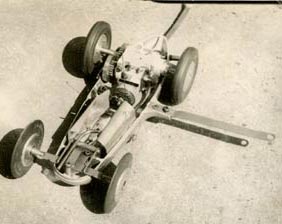 |
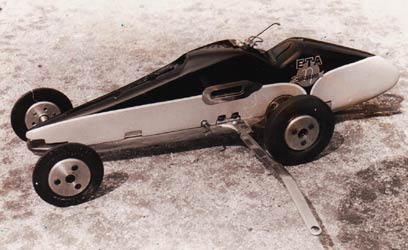 |
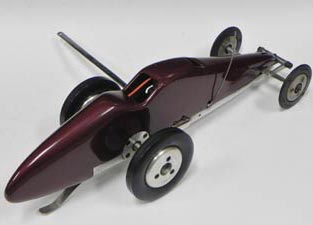 |
| 5cc car with suspension | Raced by Ken Bedford late 50s | The US car |
Joe Riding, amongst others, had published articles regarding the use of composite materials for car bodies using a variety of reinforcing materials and 'glues' to create the required shapes. Ron Thrower had gone one stage further by producing complete 1.5 and 2.5cc cars in GRP (glass reinforced polyester resin) and was working alongside Paul Zere of ZN on a 2.5cc car that could be home built using commercial components with a GRP body.
|
Whether this is what prompted 'Barry' is not known, but he produced a pan and top that were identical mouldings with the pan having a lip added to locate the top. Ken Bedford decided that this would be the ideal basis for a 5cc car using freely available commercial parts with the mouldings available from ETA and other parts, ready to assemble, from other suppliers. Ken's completed car with an ETA 29 was described in the Model Maker for October 1956 named 'The Terry Special' after his eldest son. The article goes on to say that Jim Dean had used a set of these mouldings to create a 5cc car of his own, but with a Dooling 29 and one of his own magneto ignition systems, along with his 'trademark', front suspension. Jim used his own suspension system on all his cars from the smallest upwards, but did not always run with it in place. He also used to change rear wheels on a regular basis depending on which track he was running on, which makes exact confirmation in photos of which car is which, difficult. |
|
Back in May 56 Jim Dean had published an article describing the cars he was to be running during the season including a 'gear driven 'Shadow' type car' and a 'ZN type car fitted with a magneto and a fibreglass top and bottom to the body'. This clearly confirms that the 'Terry Special' and bevel drive cars were in existence well before the start of the 56 season. Both 'Terry' cars were run at the 1956 Blackpool Nationals although not in the competition. Jim won the 10cc class but Ken did not get any runs with his 5cc car.
|
This brings us neatly round to the 'other 5cc car' and its link with the present day. The 1956 Model Maker article illustrates Jim's #11 derived car, Dooling powered, whilst the photo we have shows a similar car but with the ETA engine. A smaller photo confirms the existence of two identical cars with a very distinctive body catch on the the top of each, which still exists on Lyndon's car. This begs the question as to whether Ken Bedford actually machined up two, or even three identical pans as he had the facilities at the works and a vast engineering experience. Given that Jim only had one arm, this seems a real possibility. Further, was 'Barry' responsible for the GRP bobtail bodies on each? These were very definitely smaller versions of the body on Jim's 10cc car, rather than the style Ian Moore drew out. |
|
|
|
The photographic evidence we have shows Ken's car with Hayward wheels and tyres whilst Dean's own having McCoy or C&R rears. Yet another photo on the left shows an identical car, sans suspension but with an extended breather pipe and Dooling or Rowell rears? The car in the US has Hayward rears, but has the same body as on Ken's, not the one shown in the 1956 photos. There is an internal battery fitted in the rear compartment of the pan where a knock off switch was originally as Dean never got round to fitting a magneto. It also has a different fuel tank and another of Dean's complex ignition and fuel shut off's situated between the tank and the motor similar to that on the photos of the car with the ETA engine. This could well have been a later evolution of the car? |
|
The only real conclusions are that the Dean and Bedford bevel drive cars were both based on the Ian Moore #11 chassis pan, probably machined by Ken Bedford. Both cars may have had the Dean suspension at one stage but only the one in the US has it now. Three different bodies have been identified, which handily provide the evidence of a variety of tanks having been fitted to each car. Dean's original 5cc tanks were huge and had very long vents that extended beyond the nose of the car. An early photo of Ken's car shows one of these fitted, but a later photo indicates a more conventional tank with filler and vent exiting out of the side of the car. Later, Ken fitted the shorter and more rectangular tank, seen here, running off a pressure tapping from the rear of the engine. |
|
The relative location of tank and venturi in cars running anti-clockwise provides a perennial problem in mixture setting that is still eluding those running the older designs in that direction. Changing the direction solves the problem instantly, but is not possible with original castings. The dog leg in the pan handle can be clearly seen above, another marked difference to the ZN casting that is both longer, wider and has the bridle attachment further forward, not apparent until an original ZN could be placed alongside for comparison. Removing the fuel tank in Lyndon's or the car in the US would have confirmed that they were not of ZN origin as these all have the ZN logo cast in to the pan.
With further, more recent evidence, we can say for certain that the car in the US is Jim's 1956 car, somewhat modified. Although an on board battery has been fitted, the hole for the remote glow connector in the rear of the car is still present. There are no signs of the toggle body catch either, unless as mentioned earlier, there was a third, similar car or an entirely new body on the Dean car? Which brings us to an obscure British TV programme, which featured Henry Cole mending items in order to sell them on and one of these was a very similar ETA 29 powered car, was it a ZN or a Moore. OTW was originally invited to be part of this programme, but the production schedule was too tight, so they did a right bodge job on the restoration and we never got to see or identify the car.
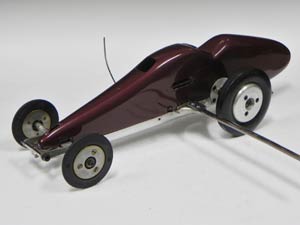 |
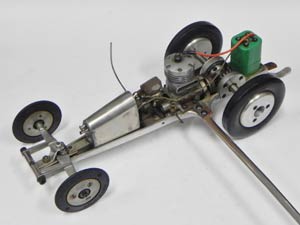 |
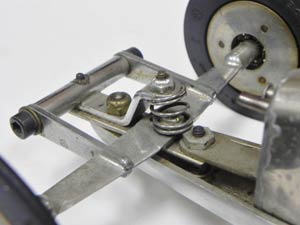 |
| Jim Dean's 1956 Dooling #11 | Modified tank, dog legged bridle | Jim's trailing link suspension |
The discovery of the origins of the Dean and Bedford cars has led to a member of the BTCG making a pattern to the Moore plan, with two new cars already being built for the 2024 season, one Dooling powered, the other ETA, so maintaining a certain symmetry. Dave Cunliffe built a copy of the Dean car some years ago, complete with the front suspension so there could be four Dean inspired #11 cars running in 2024 with two more in prospect.
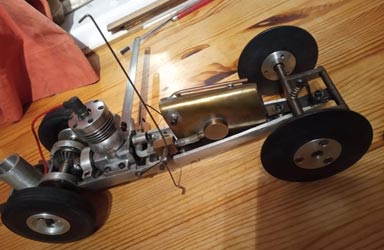 |
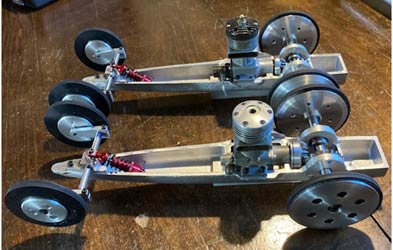 |
| Dave Cunliffe's Dean replica | Dooling and ETA #11 replicas from Oliver Monk |
This article would not have come about without the help of Lyndon Bedford, John Lorenz, Jim Hampton, Dave Cunliffe, Oliver Monk and David Giles who have all had a hand supplying information, photographs and recollections.
More Dean Discoveries
May 2025
Having run the website for the best part of two decades we are constantly amazed by the chance discoveries and spooky coincidences that happily, keep occurring. The entire article relating to Jim Dean came about as a result of two of those coincidences, firstly, his 1954 championship winning car ending up in a box in Essex, but only recognised as such through a photo from the 1950s posted on the Swiss Model Car Club site, although even this has now taken a surprising turn. Two of his innovative 2.5cc Oliver powered cars appeared in a Facebook post, whilst a 5cc car with his unique front suspension that we have already featured resides in the US.
Now it comes to the 'spooky' bit as over the course of just three weeks the purchase of two cars that purported to be something else and a visit by a reader to a neighbour selling some engines had led to some remarkable revelations. Inevitably though, these are tinged with sadness as it was only the demise of the previous owners that kick-started the series of 'oh my goodness' moments.
|
The bare facts are fairly simple, but it was what followed that provided all the excitement. Revelations began with the SAS auction and a car called 'Cooking Pot' sporting an odd shaped, home made body. Sticking out of the cockpit was what looked suspiciously like a Dooling 61 with the pan giving the appearance of a Dooling Arrow, but not confirmed by the time of the sale. Bought on spec by one of our readers, it was not until it was delivered that it began to give up its secrets. Firstly, the body was a much later addition and underneath it was a Dooling Arrow, however the combined ignition and fuel cut-off was most obviously one of Jim Dean's 'all in one' units. Further research suggests that this was one of the two cars that Jim ran in 1953, one with front suspension and this one without. The magneto follows his early design also published in 1953. |
|
What was strange though was the 'Dooling' motor as it did not look quite right, until it was taken out of the pan and photographed that is. No logo on the bypass and very thick lugs, but a Dooling in every other respect until a high resolution photo of the mounting lug shows a Dooling engine number. A standard Dooling tank has been fitted showing the original tank mounts still in place, whereas in the later car the mounts have been removed to allow a much larger, oval tank to be fitted as seen in the Zurich photo.
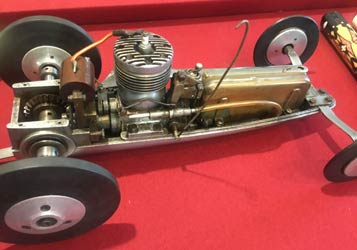 |
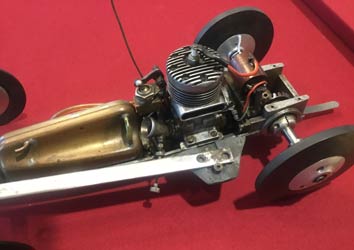 |
| Bobtail pan, Grenwyn style tyres, dropped front axle | Magnesium tether arm bracket |
What this motor had though was a stamped impression on one lug ENDURA ENGLAND. This was obviously a manufactured stamp, not individual letters and may have been Jim's company, applied to avoid questions from customs officials on his trips abroad or even to disguise its origins?
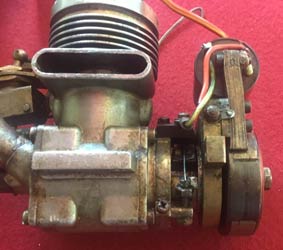 |
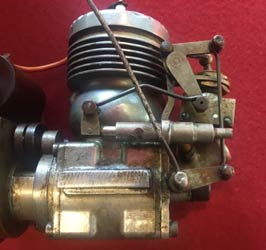 |
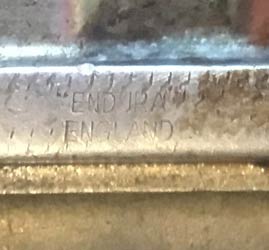 |
| Thick lugs and early magneto | Dean combined ignition & fuel cut off | Stamped ENDURA ENGLAND logo |
|
Still the connections continued as, just a week later, the new owner of the prototype visited someone nearby who was selling a bunch of engines and almost impossible to believe, there was a genuine AMRO from a tethered car. Needless to say, this he promptly snaffled. The head is a bit mangled, the Venturi and any form of ignition are both missing The coupling does look similar to those used on the Swiss AMRO based cars though, but who the original user was and how it arrived in the US may never be revealed. Another amazing discovery nonetheless. Right: Original, 1950s AMRO 61 |
|
|
|
It does not stop there though as the emails by then were flying thick and fast. Another sad loss was the death of long time competitor from Switzerland, Hans Isenegger, and that his collection was being sold. Most were modern FEMA cars, but amongst them was a Dooling Arrow, which proved to have a remarkable history of its own, but even that was not the entire story. Along with Jim Dean, a regular competitor at European meetings in the 1950s was triple European 5cc Champion Jack Cook. At the 1958 double header World and European Championships in Switzerland, Jack was running his own three cars in 5cc and 10cc as well as proxy running two of Jim's 10s as Jim was unable to travel. In a strange quirk of fate, Jim's cars were faster than Jack's at both events, which might help explain the next move. Jack's Dooling Arrow was sold after the meeting to Georg Fausch who in turn gave it to Isenegger some fifty years later as a birthday present. Left: Jack pushes off the Arrow in its 1956 configuration sans suspension |
There it remained until February 2025 when it was purchased by another great Swiss enthusiast who emailed to say that he had found a British car with a huge amount of history, little did he know? The next email included photos of the car, which enabled us to unlock an even more amazing provenance for the car. Firstly, it had the front suspension unique to Jim Dean. Secondly it had the fuel and ignition cut-offs in a single unit attached to the motor backplate, another Dean trademark, thirdly, a very large oval, Dean tank, and finally, one of Jim's own, very recognisable, magnetos of his later design. It had obviously started life as a standard Arrow as the stubs of the two tether brackets were still evident though now it had a pan handle conversion and had received the full quota of Dean modifications, but how and when?
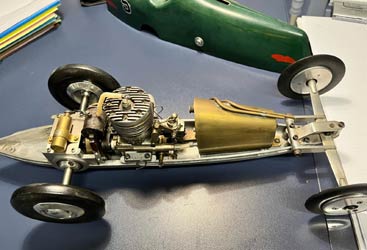 |
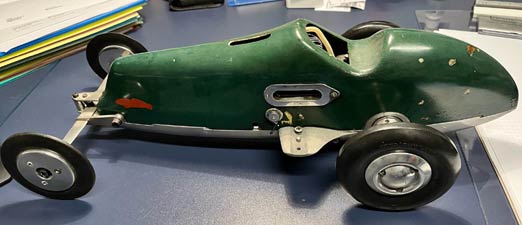 |
| Dean features in a standard Arrow pan | Untouched since 1958 World and European Championships |
The clues could lie in a ModelMaker report from May 1956, where Jim describes the cars he was preparing for the season, a 'bobtail' for himself and one using a standard Arrow pan for an old 'college friend' Eric Grimwood to run as part of 'Scuderia Dean'. However, no evidence exists that Eric ever ran this car, so the probability is that it was the basis of the car passed on to Jack to run in the 10cc class as he was primarily a top 5cc competitor. Jack was also one of the founders of the UK Dooling Owners Club.
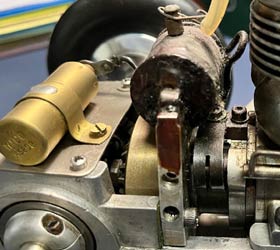 |
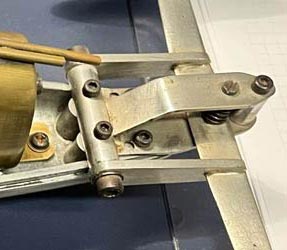 |
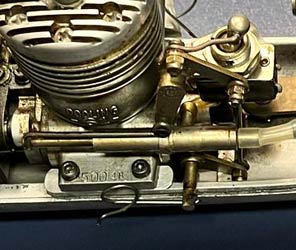 |
| Three features unique to Jim Dean's cars | ||
| Home built Magneto replacing Dooling support bracket | Extended front suspension, again a Dean trademark | Ignition and fuel cut off unit attached to the motor that can be removed in one piece |
As an aside there is an interesting comparison between the suspension on the 5cc car, which features trailing links with the pivot extended in front of the car and the 10cc car with its leading links, which extends the wheelbase a bit with the pivot picking up on the original axle mounts. Oddly, none of Jim's 10cc cars have been found with the front suspension in place, so did one of them donate the front end to this car between 1956 and 1958?
In less than a month, two cars with a very obvious Dean connection have emerged, and with a great deal of research and cross referencing of photos and results, there is little doubt that the car sold at SAS was Jim's 1953 Championship winning car, albeit now with a conventional Dooling tank and the later Dean combined fuel and ignition knock off. This Jim alludes to in his 1956 article as he mention the new arrangement to overcome weaknesses in the previous version that operated through the cockpit opening. Along with all this, a production AMRO 61 turned up, a contact who thinks he might be on the trail of another Dean car and an intriguing insight in to the journey of Jim's cars from the end of the 50s through to their disposal.
We cannot be certain of the chain of events from 1958 onwards until Jim's intention to sell his cars, but it appears that the prospective sale never took place as several cars subsequently appeared at The Model Engineer Exhibition at Wembley conference Centre around 1977/78 following Jim's death. We now know the two 10cc bobtail Arrows were bought by collectors in London, the 5cc bobtail Moore #11 ended up in the US as did one of the unique 2.5s, but of all the other 2.5cc and 5cc cars, not so much as a sniff. Having all this come to light in such a short space of time and being able to put it all together is, as one of our correspondents so succinctly put it, 'why we get up in the morning'. All these discoveries have required modification to the original conclusions in the full article and a realisation that not everything is quite as it seems. Two adjacent pages in Kurt Zahnd's photo album have the photos seen on the previous page, one captioned with the record and winning speed from 1953 and the other of Jim showing his car to a young onlooker with just the Sept part of the date showing. Going back to the original on the SMCC site revealed that this page had one photo from 1956 and one from 1958 as it also showed the American contingent. Even primary sources can mislead at times if the wrong inferences are made. The 1953 photo does show Jim's second car in the background, another bobtail but with the front suspension.
Thanks go to Charlie Murphy, Christoph Zaugg, John Lorenz and David Giles for all the details and photographs. The speculation is entirely down to OTW.
ęcopyrightOTW2025